Posted by Anita on 06.06.08 7:18 AM
 Oh, hi — are you still here? Dang, sorry about that. We’ve done the metaphorical equivalent of falling asleep at the WordPress dashboard, and yet you kept coming by. That’s so sweet.
Oh, hi — are you still here? Dang, sorry about that. We’ve done the metaphorical equivalent of falling asleep at the WordPress dashboard, and yet you kept coming by. That’s so sweet.
But enough navel-gazing: We’re back! We’ve got a great few posts in the hopper, including a brand new eat-local challenge for the summer. First, though, I think we’re definitely overdue for a drink.
One of the cool things that happened before our spring slump kicked in was Cocktail Week: Seven whole days devoted to well-made libations, visits from cocktail illuminiati, and some of the city’s best restaurants offering multi-course meals with inventive cocktail pairings. (Imagine eight pork dishes — including two delicious desserts — with seven different American-whiskey cocktails: Foodie hotspot Orson hosted this Bourbon & Bacon extravaganza, and I dream of it still.)
Another night, the folks at CUESA hosted a Farmers Market Cocktails tasting in the arcade of the legendary Ferry Building. At the mercy of one of those unseasonably hot days we get each May, a few hundred cocktail fans packed under the archways like a tin of tipsy sardines. Happily, we ran into many of our local blog buddies, which made for fabulous chit-chat as we sampled and sweltered.
Sadly, although I love fresh–fruit cocktails, Cocktail Week falls at possibly the worst time of the year for that sort of thing. Specialty citrus is pretty much gone, stone fruits are weeks away, and there’s not much on hand but some early-season strawberries and underripe cherries. As a result, I was not captivated by many of the drinks we tasted at the event, despite their being created by some of the best bartenders in town.
The best sip of the evening was the official drink of San Francisco Cocktail Week 2008: The Soirée. It features both green Chartreuse and St-Germain elderflower liqueur — two of my favorite ingredients — woven together with the muskiness of silver tequila, a sour punch of lemon, and the whispered spice of a Latin-inspired tincture. It sounds like the sort of crazy mess you might expect from a collaboration of a trio of star bartenders… but it’s actually delicious. (Of course, it didn’t hurt that the version we sampled that night was shaken up by one of our favorite mixologists.)
The chile-cinnamon-cocoa tincture — definitely not optional — requires a little effort, but the ingredients can be found in any decently stocked bulk foods department. With a quick shopping trip, a few minutes of prep, and a little patient steeping, you can throw your own Soirée whenever the mood strikes.





The Soirée
1.5 ounces silver tequila
1/2 ounce St. Germain elderflower liqueur
1/2 ounce green Chartreuse
1/2 ounce lemon juice
2 dashes mole tincture
Mint, for garnish
Shake all ingredients with ice, and strain into a chilled cocktail glass. Garnish with a sprig of mint.
Mole Tincture
1 cinnamon stick, broken into pieces
3-1/2 T cacao nibs
1/4 red bell pepper, minced
1 dried very hot chile (such as de arbol)
5oz silver tequila
Place all the ingredients into a jelly jar with a tight-fitting lid. Shake the jar twice daily for four days then strain the mixture, first through a sieve, then through a coffee filter before bottling.
Drink of the Week, drinks, farmers markets, recipes
7 Comments »




Posted by Anita on 04.06.08 12:03 PM
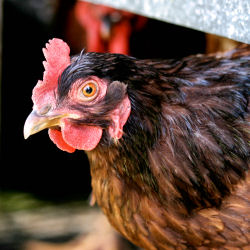 Before Niman Ranch started raising their herds on Iowa feedlots, their marketing materials bragged about “happy cows with ocean views”. Last Sunday, as we popped over the crest of Pierce Point Road and saw limitless green pasture dotted with black steers overlooking the deep blue waters of the Pacific, I gasped: It was exactly the scene that I’d held in my mind’s eye all these years. Only this land and these cattle belong to Marin Sun Farms, the ranch that supplies us with most of our eggs and meat.
Before Niman Ranch started raising their herds on Iowa feedlots, their marketing materials bragged about “happy cows with ocean views”. Last Sunday, as we popped over the crest of Pierce Point Road and saw limitless green pasture dotted with black steers overlooking the deep blue waters of the Pacific, I gasped: It was exactly the scene that I’d held in my mind’s eye all these years. Only this land and these cattle belong to Marin Sun Farms, the ranch that supplies us with most of our eggs and meat.
Even a week after our visit, I’m having a hard time expressing the depth of my awe for what David Evans is doing out on his Historic H Ranch, just 50 miles north of San Francisco. David’s family has farmed this same land since the early 1900s, although they were forced to sell it in the 1970s under the eminent domain act that created the Point Reyes National Seashore. The family leases back the land under what seems to be very tenuous circumstances: 5 year terms and government oversight of terribly minute details like the size of chicken flocks. Needless to say, it’s not the sort of sustainable permanence that makes this consumer particularly content.
Pronounced David’s way, the enterprise responsible for much of our weekly protein is properly known as “Marin Sun Farms” not “Marin Sun Farms.” Like his mentor Joel Salatin — who famously explained to Michael Pollan that he was a “grass farmer” — David takes pains to emphasize that his husbandry converts solar energy, by way of living pasture, into proteins that humans can digest. It’s half clever and half hokey, but undeniably true.
We started our tour overlooking the pasture where cows and calves ambled up and down spring-green hills, lolling in the lush grass or drinking from a large, clear pond. David talked at length about his ideology and his farming methods, explaining how herds — both chickens and cows — are moved to a different patch of land each week, preserving the pasture from over-grazing and enhancing the soil with their manure.
We peeked into a converted freight trailer turned chicken nursery, spying four gaggles of Easter-perfect chicks peeping around under heat lamps, pecking away at their feed. From there, we strolled down a wide lane to look in on David’s sister’s goat herd, busily clearing a scrubby yard where vegetables had been grown over the previous winter.
Beyond the goat yard, we saw two quonset hut-shaped structures on a distant hillside, our first glimpse of the farm’s egg-laying operation. Built of canvas-like material stretched over simple wood frames, these chicken houses open directly onto open pasture, without any physical barriers to any one of the chickens flying or wandering off. Apparently their social structure makes that unlikely; they’re much more apt to leave in the clutches of a predator, according to David. Perhaps half of the chickens roosted inside their homes, and the remainder scratched and pecked and flapped away outside in the open air. Glancing at the wide range of breeds, I suddenly understood the diversity of the colors and sizes of the eggs in our weekly dozen.
Many of us remarked with surprise that this egg-laying flock included a fairly large number of roosters, in addition to the laying hens. “I don’t do it so we can say the eggs are fertile,” said David, “But I know that I wouldn’t be happy in an environment without females, and I don’t think any of you ladies would be happy in a world without men.” Even as an unrepentant omnivore, it’s hard to wrap your brain around someone who makes his living selling meat treating his product with such humane regard.
Up the road a piece, we called on the broiler flocks, grown-up versions of the fuzzy peeps we’d seen pecking in the nursery. Penned in movable, mesh-covered yards — half in sun, half in shade — these birds were, quite frankly, the ugly ducklings of the farm. Where the laying hens are diverse and beautiful, Cornish Cross broilers look like the freaks of nature we’ve bred them to be. Sparsely feathered, dull around the eyes, and unbelievably gawky, these aren’t birds you feel too much sentiment toward. Still, they’re cared for with the same meticulous attention. They’re fed organic cracked grain, supplementing all the insects and grubs they can forage from their patch of pasture. At the end of the week, when they’ve cleared the pests and fertilized the land beneath their enclosures, their coops are canted up on a large dolly and rolled forward to a new stretch of green grass.
Sounds bucolic, and it certainly looks that way, too. Are things 100% perfect on this pastoral land? I’m sure they’re not. I would have been happier not knowing that Marin Sun Farms broiler chicks are fed imported Chinese soy until they’re old enough to digest corn and grubs. Or that David feels that heirloom birds are just too expensive (twice the cost of the already pricey hybrids he brings to market, he says) and don’t taste any better than the ugly mutants. Or that most of the calves born at his parents’ H Ranch operation are destined for life on the feedlots of the Midwest, because there simply isn’t enough demand for pasture-raised beef. But despite all of the things that I wish they were doing more-perfectly, the simple fact is that I am in awe of the 99% that Marin Sun Farms is doing exactly right.
Rounding our way back to the main barn, David stopped to talk about the on-farm ‘processing’ — that is, slaughtering — that farmers are, thankfully, still allowed to do for their own poultry. As he explained that the next part of the tour was occasionally more than some visitors had bargained for, I finally focused beyond David’s shoulder, at last noticing a critical part of the farm that had previously escaped my notice. Having read Michael Pollan’s description of the Polyface Farms “abattoir without walls,” I knew enough to recognize it: The metal cones where chickens are killed and bled out, the plucking machine with its hundred rubber ‘fingers’, the well-worn worktables, the buckets for the blood and guts that get turned into the compost pile to amend the land. No roof, no walls; everything open to the sun and the wind, nature’s original sanitizers. It was all right there… right there for anyone to see, to understand.
I knew well enough we wouldn’t see any chickens slaughtered that Sunday — it happens on Thursdays, anyway, and the oldest of this season’s broilers were still a week from market, merrily clucking away in the pasture. Nothing had been slaughtered here since the old roosters and hens had come to market last winter; the killing place smelled of nothing but the hillside around us. And yet, it had the undeniable air of purpose. I won’t insult you by saying it felt holy, but I do know that there was no nervous laughter, no chatter, no wandering off to investigate something more interesting around the corner. Every one of us on that tour, kids included, was completely present there, standing inside the boundaries of the place where animals became food: The place where each bird experiences what David calls its “one bad day” on the farm.
—-
When the tour was over, we caravaned back over the road to Route 1. David treated everyone to lunch at the Marin Sun Farms Butcher Shop, a bountiful spread of Della Fattoria bread, the farm’s own rib eye and roast goat, bowlsful of aioli and horseradish cream and salsa verde, and buckets of German-style potato salad with flecked with rich bacon.
But the best part of the lunch was the beverage: David brought out “a gift” — which he couldn’t legally sell to us — of a few gallons of raw milk “just hours out of the cow” in oversized Mason jars. I’d shied away from buying raw milk at the stores, imagining that it would taste grassy or gamey. But oh, lord, what I’d been missing! It just tasted more milk-y, like a better version of the best milk you’ve ever had. Nuances of flavor, texture, and color are apparent even to the most casual observer.
Needless to say, we bought a quart of Claravale raw milk this Saturday, and I don’t expect to go back to the sterile, flat stuff anytime soon. Nor do I expect I will soon forget the windy spring morning when I looked my supper in the eye and made peace with my place on this sustainable food chain.





Marin Sun Farms
10905 Shoreline Highway
Point Reyes Station, CA 94956
415-663-8997
Meat CSA memberships available starting at $270 for a 6-month session
Retail sales available at the Point Reyes butcher shop, Saturday Ferry Plaza Farmers Market and Sunday San Rafael Civic Center Farmers Market
Next farm tour: May 18, 2008
Adults $30, Kids $10
(Pre-registration is mandatory)
Dark Days challenge, farmers markets, farms & farmers, locavore, meat, shopping
13 Comments »




Posted by Anita on 04.02.08 12:14 AM
As if our constant prattling here on our own site wasn’t more than enough to keep you occupied, we’re happy to announce a few other places around the Interwebs where you can see more of our content.
 Later this month, I’ll begin a regular column for Hearst’s new sustainable-living site, The Daily Green. (The site’s technically still in soft-launch mode, so be gentle.) I already work with words in my ‘real job’, so I’d never really felt the need to pursue new outlets for my writing. But I’ll admit I was swayed by the idea of rubbing elbows with some folks whose work I greatly admire: TDG’s other “New Green Cuisine” bloggers include James MacKinnon & Alisa Smith — the 100 Mile Diet / Plenty folks — and food watchdog extraordinare Marion Nestle.
Later this month, I’ll begin a regular column for Hearst’s new sustainable-living site, The Daily Green. (The site’s technically still in soft-launch mode, so be gentle.) I already work with words in my ‘real job’, so I’d never really felt the need to pursue new outlets for my writing. But I’ll admit I was swayed by the idea of rubbing elbows with some folks whose work I greatly admire: TDG’s other “New Green Cuisine” bloggers include James MacKinnon & Alisa Smith — the 100 Mile Diet / Plenty folks — and food watchdog extraordinare Marion Nestle.
The column I’ll be writing for The Daily Green will be a roundup of Sustainable, Organic, Local, Ethical eating tips called “SOLE Food Digest”, a weekly collection that aims to show readers how to tread lightly and still enjoy what they’re eating. I’ll be recapping and linking off to as many inspiring posts as I can find. No wonky policy discussions, no alarmist scary-food nightmares — just links to constructive tips, seasonal recipes, and stories about encouraging changes in our food supply… green-eating inspiration with a can-do spin.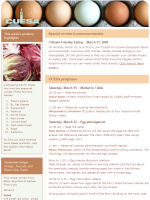
I hope SOLE Food Digest will become the perfect jumping-off point folks who are just starting down the SOLE path, and for old-time ethical eaters looking for a lighter touch. (I’ll post a link as soon as it’s live, hopefully on or soon after Earth Day.)
I’m also tickled to tell you that the good folks at CUESA — they run the Ferry Plaza Farmers Market, among other great locavore resources — have asked me to contribute photos to their newsletter and site. Those pasture-raised eggs in the banner of the March edition of the CUESA Weekly E-Letter are mine; look for my “married with dinner” photo byline, and more of my photos in upcoming editions of the newsletter, and also on the CUESA homepage in the coming months.
 A little further afield: Cameron and I are joining 30 or so of the world’s favorite drink bloggers to produce the Tales of the Cocktail blog. All of us will be live-blogging from New Orleans in July, of course, but you won’t want to wait to put the Tales blog in your RSS reader. There’ll be plenty of pre-event posts covering all sorts of topics that are sure to pique your interest, even if you’re not planning to attend the year’s most anticipated cocktail event. And if you are joining us in New Orleans, don’t forget to head over to the main Tales of the Cocktail site, where tickets
A little further afield: Cameron and I are joining 30 or so of the world’s favorite drink bloggers to produce the Tales of the Cocktail blog. All of us will be live-blogging from New Orleans in July, of course, but you won’t want to wait to put the Tales blog in your RSS reader. There’ll be plenty of pre-event posts covering all sorts of topics that are sure to pique your interest, even if you’re not planning to attend the year’s most anticipated cocktail event. And if you are joining us in New Orleans, don’t forget to head over to the main Tales of the Cocktail site, where tickets have just gone on sale will go on sale real soon now, and discount ($99!) rooms are available for the show hotel, the venerable Hotel Monteleone.
And last but not least… I’m assured that this is not just some elaborate April Fool’s Day joke: Our post about Armandino’s Salumi is featured rather extensively in the Internet Explorer 8 Activities demo. We have no idea how this happened, and the irony is not lost on us that we’re diehard Firefox/Mac fans here at Married with Dinner HQ.
drinks, farmers markets, geekery, other blogs
14 Comments »




Posted by Anita on 12.10.07 12:01 AM
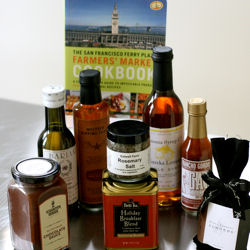 “Best of the Ferry Building” Gift Basket
“Best of the Ferry Building” Gift Basket
An assortment of more than $100 worth of treats from San Francisco’s legendary Ferry Building Marketplace: Peet’s holiday blend breakfast tea, Scharffen Berger chocolate sauce, Recchiuti burnt caramel almonds, Bariani olive oil, Rancho Gordo hot sauce, Prather Ranch marinade, Eatwell Farm rosemary salt, lemon-infused Sonoma Syrup. You’ll also receive a copy of the popular Ferry Plaza Farmers Market Cookbook.
To give you something to remember us by when all the goodies are gone, this prize also includes the winner’s choice of an 8×10 print from our collection of market photos.
International bids are welcome, but winners outside the Continental US will be asked to pay for any shipping fees over our US$25 limit.
This item is Menu for Hope prize UW-06.
– Click here to make a donation and enter to win.
– Read the Menu for Hope overview to learn more.
farmers markets, Menu for Hope
1 Comment »




Posted by Anita on 10.31.07 7:05 AM
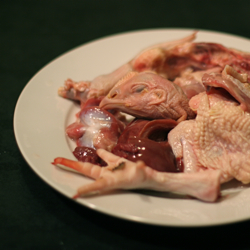 Once upon a time, there was a spoiled teenager named Anita who refused to eat ribs, chicken legs, or any other meat shaped like a body part.
Once upon a time, there was a spoiled teenager named Anita who refused to eat ribs, chicken legs, or any other meat shaped like a body part.
One year, the child’s mother took ill on Thanksgiving morning, with a gaggle of relatives due to descend upon the family home in mere hours. The mere thought of sticking her hand inside (inside!) the body of a turkey made the girl turn green around the edges, but there was nothing to it but to do it: In went the hand, out came the slimey giblet bag. In a word: Gack!
Years later, the girl grew up and got over herself. A culinary school butchery class, which involved parting out cases of chickens and breaking down sides of beef, rid her of the last vestiges of meat squeamishness. The woman became secure with her place on the food chain, an unrepentant carnivore at last.
Flash forward to 2007: In a crisis over the disappearance of Hoffman Farms chickens from the local farmers market, we started buying our weekly roaster from Marin Sun Farms. We’d blithely strolled past their stand for months, seeing the signs for chickens, never venturing in to price them; our Hoffman loyalties were that strong. But the disappearance of their main competition emboldened these farmers, and they began putting their wares on more prominent display: First in bins by the edge of their stall, then moving to a large, copiously iced display — complete with protruding chicken feet — right out in the pathway. (Just the other day, I saw a group of tourists laughing nervously and taking pictures; it’s quite the sight if you’re not used to such things.)
The first afternoon of our patronage, we brought our fine-footed fowl home. The idea of cutting off chicken feet didn’t faze me a bit, I smugly noted. It wouldn’t be any worse than snipping off wingtips, really. I’d seen enough dim sum to grasp the comic possibilities of disembodied chicken feet, and I knew their gelatinous cartilage would add body to our next batch of stock.
I plopped the bagged bird in the sink and turned on the water. Cutting through the rubber band that held the bag shut, I accidentally grazed my arm on a stray claw. (Note to self: Chickens — at least the ones that aren’t factory-gorged on corn — scratch for their supper.) But the sting of avian revenge was no match for the shock I got when I pulled Henny Penny out of the bag: Her frickin’ head was still attached!
Or, well, mostly attached. The neck had been slashed (quite tidily) and her noggin wobbled around on the impossibly long neck in a rather ghastly fashion. Her tiny eyes were mercifully shut, but you could quite clearly make out what her features must have looked like, mere days ago. A tiny comb was clearly visible at the crown of her egg-sized skull. Oh, my…
Snapping out of my guilt-laden reverie, I laughed aloud, amused at how a small, dead hen could rattle me so. Would I have bought her, had I know she came fully equipped? Probably. But coming upon an unexpected beaky face in the bottom of the bag was more than I was expecting. I wondered whether the farmers enjoyed imagining the shock they inflicted on unsuspecting city slickers, but most likely they never gave it a moment’s thought. It’s a chicken, to them. Their livelihood, our supper.
It gets easier, week by week, staring my dinner in the face on a Sunday afternoon. I’ve even come to see the gallows humor in the macabre ritual of removing heads, necks, and feet. I’m not sure I could ever kill a chicken, maybe not even gut a dead one (I’m still not all that happy about innards, truth be told). But if I’m going to be an ethical carnivore, I figure that looking my meat in the eye is the least I can do. And so I do, with silent thanks to the farmer and the chicken.
And then I cackle like a fiend as I throw the dismembered bits in the stockpot. Muuu-huuu-huuu-ahhh!

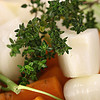



Chicken Stock, Simplified
4 to 5 pounds raw or frozen chicken bits (wings, backs, necks, and feet)
6 quarts filtered water
1 pound mirepoix, very large dice (1 inch or so)
– 1 large onion
– 2 medium carrots
– 2 large celery stalks, trimmed
Bouquet garni
– 2 cloves garlic
– 8 peppercorns
– 3 whole cloves
– 2 fresh thyme sprigs
– 6 parsley stems
…tied with twine in a cheesecloth bundle
In your largest pot, bring water and chicken parts to a simmer; reduce to a lazy bubble and cook for 3 hours. Add the mirepoix and bouquet garni and cook for an additional hour. Strain through cheesecloth or a very fine mesh sieve into a large bowl (or a cool stockpot). Cool to room temperature using an ice-water bath or immersible stock chiller, then chill completely overnight.
The next day, skim the fat and measure stock in 2-cup portions into quart-size freezer bags. Holding the bag upright, squeeze to remove excess air, then seal. Freeze bags flat on a rimmed cookie sheet until completely solid; they can then be stored in your freezer’s pull-out bins, filed like flip-cards along with pasta sauce and other flat-packed liquids. Any odd measures of stock can be frozen in ice-cube trays for quick use in pan sauces and other recipes requiring small amounts of liquid. Store frozen stock for up to 6 months.
cooking, farmers markets, locavore, meat, recipes
16 Comments »




Posted by Anita on 10.23.07 1:37 PM
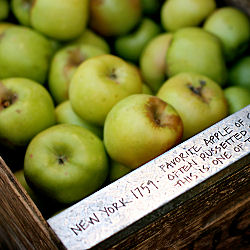 When I think about the bloggers participating in the Dark Days Challenge in places like Maine or Minnesota or Michigan — places where winter actually involves snow, frost, and farmers markets that close for the season — I feel like a fraud.
When I think about the bloggers participating in the Dark Days Challenge in places like Maine or Minnesota or Michigan — places where winter actually involves snow, frost, and farmers markets that close for the season — I feel like a fraud.
We still had tomatoes at our market this weekend — heirlooms and Early Girls and a rainbow of Sweet 100s — from a surprising number of farms. They sat there in their little cliques, cozying up to their buddies, red peppers and basil. You could almost imagine them standing in front of a mirror inspecting their own summery plumpness and silently mocking the homespun pumpkins and Brussels sprouts on the next table over.
Frankly, I’m over these cheeky girls of summer. I’m ready for the potatoes and the greens and the crisp new apples. It’s a little eerie to realize that I could eat today the same meals we made in June without even leaving the market. I even saw three different vendors who were still selling strawberries… they’ve been on the farm tables since the first week of April, for goodness sake. I’ll be sad when the pasture-raised chickens come to an end, but that’s really all I’m going to miss from summer. Autumn is my favorite eating season.
 We started out our Dark Days Challenge last week with some of our favorite standbys. We make these dishes a lot, and we’re pretty dialed in on where to find their ingredients from local sources. And I suppose that’s one of the benefits of eating locally all the time: With the exception of farmers dropping out of your market, you pretty much know where to find your favorite things, after a while. You also know, eventually, what’s hard (or even impossible) to find; it makes you more alert when you spy something you haven’t found locally before.
We started out our Dark Days Challenge last week with some of our favorite standbys. We make these dishes a lot, and we’re pretty dialed in on where to find their ingredients from local sources. And I suppose that’s one of the benefits of eating locally all the time: With the exception of farmers dropping out of your market, you pretty much know where to find your favorite things, after a while. You also know, eventually, what’s hard (or even impossible) to find; it makes you more alert when you spy something you haven’t found locally before.
Speaking of which, our friend Cookie turned me on to a local source for wheat flour and polenta. Although Full Belly Farms is about 100 miles away, they don’t come to my local market — they sell at weekday markets in places I can’t get to during the workday, plus one Saturday market down in Palo Alto, 30+ miles south of us. So now I get to make the choice about whether it’s better to drive an hour to buy the local option, or stick with my carb exemption. The other good news is that I found out (from Cookie, again) that the white rice we’ve been buying is harvested semi-locally… about 150 miles away.
Here’s what last week looked like:
Chicken & Dumplings
– Marin Sun Farms chicken; onions, carrot, celery from the market; garden herbs
– biscuit mix from Beth’s in San Rafael; Clover Organic milk
Chili Dogs (can’t watch the playoffs without ‘dogs!)
– Prather Ranch uncured hotdogs and Acme pain de mie buns
– Chili made with our own tomato sauce and homemade pork sausage, plus Prather chuck
– Eatwell Farms onions, and non-local (but organic) cheese
Oxtail Ragu and Pasta
– Marin Sun Farms oxtails braised with our own chicken stock and tomato sauce
– salad: red-leaf lettuce (Little), avocado (Will’s) and tomatoes (Everything Under the Sun)
– non-local dried orecchiete pasta
Pork & Potatoes
– Double-cut Prather Ranch pork loin chop on the grill
– Roasted Iacopi Farm brussels sprouts with Bariani olive oil
– Roasted ‘rose Finn apple’ potatoes from Mr. Little
Pasta (Not-Quite-)Bolognese
– meat sauce made with Prather beef and pork, Mariquita tomatoes, Eatwell onions
– garlic bread: Clover Organic butter, Acme rolls, local garlic
– non-local dried pasta
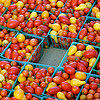


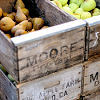
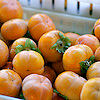
farmers markets, locavore, other blogs
10 Comments »




Posted by Anita on 09.27.07 8:04 PM
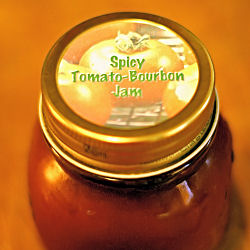 Making your own preserves may not exactly be the world’s simplest kitchen task. But if you limit yourself to a relatively small batch, and pick the right recipe — preferably one that avoids the canning process altogether — it can be a lot of fun. A lot more enjoyable than say, the back-breaking labor and knuckle-biting stress of processing 100 pounds of San Marzano tomatoes. (Details on that soon… promise.)
Making your own preserves may not exactly be the world’s simplest kitchen task. But if you limit yourself to a relatively small batch, and pick the right recipe — preferably one that avoids the canning process altogether — it can be a lot of fun. A lot more enjoyable than say, the back-breaking labor and knuckle-biting stress of processing 100 pounds of San Marzano tomatoes. (Details on that soon… promise.)
Tomato jam may seem like an odd beast, but it’s really not too far removed from ketchup. My favorite use for this spicy-savory preserve is spread liberally onto good Acme white bread, topped with Fatted Calf bacon and a wedge of Will’s avocado — a sort of post-summer BLT substitute. (We served tea-sized versions of these exact sandwiches at our housewarming party, and they disappeared faster than I could assemble them.) The jam also makes a glorious glaze for meatloaf, a dipping sauce for empanadas… really, the possibilities seem endless.
If you want to simplify even further, omit the seeding and straining. It won’t hurt the flavor of the final product, and it shaves another 15 or 20 minutes off your prep. Myself, I prefer the seedless version. But then, I am all about gilding the lily.
Need more bright ideas for preserving summer’s veggie bounty? Over at The Passionate Cook, Johanna’s hosting this month’s edition of “Waiter, there’s something in my…. [Savoury Preserves]”. Check back here in a few days for a link to the roundup in the comments.
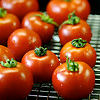


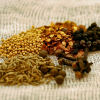

Spicy Tomato-Bourbon Jam
3/4 cup sugar
3/4 cup bourbon
3/4 cup cider vinegar
3 pounds tomatoes (preferably dry farmed)
1 tsp black peppercorns
8 whole allspice berries
8 whole cloves
1 tsp red-pepper flakes
1/2 tsp mustard seeds
1/2 tsp whole cumin seeds
Combine the vinegar, sugar, and bourbon in a glass or ceramic bowl. Stir to dissolve sugar, then set aside.
Prepare an ice-bath. Stem the tomatoes, but do not score them or remove their cores. Working in batches, blanch the tomatoes in boiling water until their skins start to split — a step beyond what you’d normally do if you wanted the tomatoes to stay firm. The timing will depend on each tomato’s size and ripeness, so keep tongs or a slotted spoon handy to check them regularly. As soon as each tomato splits, remove it and plunge into ice water. Peel off tomato skins and discard.
Make a spice sachet by placing all of the spices in the center of a square of cheesecloth and tying into a bundle with a piece of kitchen string.
Set a wide-mesh strainer over a medium bowl. Pull open each tomato gently, and use your fingers to remove the seeds and seed jelly from each pocket, letting them fall into the strainer. Place the seeded tomato pulp onto a cutting board set over a rimmed cookie sheet.
When all tomatoes are seeded, rough-chop them and place them in a large saucepan along with any juices from the cutting board. Add the vinegar-sugar-bourbon mixture and the spice sachet, and bring to a boil. Do not leave unattended, as the mixture will greatly expand as it comes to a boil.
 Using a spatula or wooden spoon, push the liquid surrounding the seeds through the strainer as much as possible. (This is where much of the flavor hides, so don’t stint here.) When you’re left with a dryish mass of seeds, discard them and add the liquid in the bowl to the saucepan, along with any puree on the underside of the strainer.
Using a spatula or wooden spoon, push the liquid surrounding the seeds through the strainer as much as possible. (This is where much of the flavor hides, so don’t stint here.) When you’re left with a dryish mass of seeds, discard them and add the liquid in the bowl to the saucepan, along with any puree on the underside of the strainer.
Reduce the heat to medium and, stirring occasionally, cook the tomato mixture 45 minutes or until it reaches a jammy consistency. Discard spice bag and divide tomato jam among sterilized jars or transfer to a container with tight-fitting lid. Let cool on countertop, then refrigerate until ready to use.
Note: Because this jam is not processed for storage, it must remain refrigerated. It will keep for about a month, provided you use a clean spoon every time.
farmers markets, locavore, other blogs, preserving & infusing, recipes
6 Comments »




Posted by Anita on 09.10.07 1:04 PM
 It’s been a gazpacho-filled summer for us. In addition to the traditional Spanish soup’s regular appearances on our warm-weather menus, we kicked off tomato season with Cookie’s gloriously deconstructed version, and were lucky enough to sample Sean’s gorgeous white Andalucian gazpacho, too.
It’s been a gazpacho-filled summer for us. In addition to the traditional Spanish soup’s regular appearances on our warm-weather menus, we kicked off tomato season with Cookie’s gloriously deconstructed version, and were lucky enough to sample Sean’s gorgeous white Andalucian gazpacho, too.
Now, I love me a straight-ahead gazpacho as much as the next tomato fanatic — that magical combination of cucumber, pepper, tomato, and vinegar is nearly unbeatable when it’s too hot to cook. But with two show-stopping variations fresh in my mind, I craved something equally appealing for Tami’s second Super Soup Challenge.
Rummaging through my library copy of Mitchell Davis’s Kitchen Sense, I spied a likely candidate. Much like the watermelon salad we brought to DPaul’s party last month, this fruit-based gazpacho is actually a savory appetizer, not a dessert. But it’s still easy as pie.
After rough-chopping all the veggies — all of which are in season and readily available from local farmers markets — you simply whiz them all together with a few simple seasonings, strain out any remaining bits, and chill for an hour in the fridge. At serving time, a pair of salty garnishes teams up with your best olive oil to add a touch of contrast. Drizzling the olive oil off the edge of a spoon gives the sparkle of beautiful small droplets.


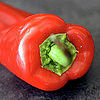


Watermelon Gazpacho
– adapted from Kitchen Sense
1 6-pound ‘icebox’ watermelon, red-fleshed
2 Kirby cucumbers or 1 hothouse cucumber, peeled (seeded, if necessary) and chopped
1 fresno chile or other medium-hot red chile, chopped
1/4 large red pepper, cored, seeded, and chopped
1/2 medium red onion, chopped
2/3 cup tomato juice
1/4 extra-virgin olive oil
1/4 cup sherry vinegar
1/2 tsp kosher salt
fresh-ground black pepper
—–
2 oz feta cheese, crumbled
3 T finely chopped Kalamata olives
your best olive oil, for drizzling
Remove the rind from the watermelon. Cut the flesh into chunks and remove the seeds, if necessary; you should have about 6 cups of melon. Using a stick blender, traditional blender, or food processor, blend all soup ingredients (except the garnishes) until well liquified — about 1 to 2 minutes. Strain the puree through a large-mesh strainer to remove any lingering seeds or other bits, pushing the pulp through with a spatula. Adjust seasonings as needed, and chill for at least an hour. Serve garnished with the feta and olives, and a drizzle of olive oil.
Serves 6 as an appetizer
cookbooks, cooking, farmers markets, locavore, other blogs, recipes
10 Comments »




Posted by Anita on 07.10.07 1:14 PM
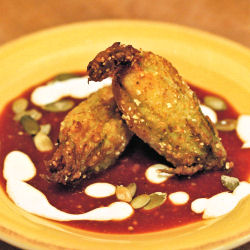 Every summer, I walk by baskets of squash blossoms at the farmers market, longing to find a use for them. Stuffing fragile flowers seemed like a tedious task for a weeknight meal, so I’d always given them a pass. But once I saw Jen’s fritters — which were in turn inspired by a course at Derrick and Melissa’s much-discussed dinner party — I knew I couldn’t put it off any longer.
Every summer, I walk by baskets of squash blossoms at the farmers market, longing to find a use for them. Stuffing fragile flowers seemed like a tedious task for a weeknight meal, so I’d always given them a pass. But once I saw Jen’s fritters — which were in turn inspired by a course at Derrick and Melissa’s much-discussed dinner party — I knew I couldn’t put it off any longer.
The basic idea seemed simple enough: Stuff the blossoms with cheese, dredge them in dairy and starch, and fry until golden. But I wanted to dress them up a bit — make them nice enough to serve as a light supper, alongside a simple salad — so I turned to my new favorite cookbook, Big Small Plates. The text of this popular title is written by Cindy Pawlcyn (of Mustards Grill fame) but the recipes themselves are largely the work of her two partners: Pablo Jacinto, the chef at Cindy’s Backstreet Kitchen, and his brother Erasto, who holds the same title at Mustards.
The book’s tapas-style approach draws inspiration from around the globe. There are plenty of straight-up California-American preparations, and Asia is well represented: A Vietnamese mini-burger salad we tried was especially delicious. But — and here I must admit to being biased — it’s the book’s Latin-influenced dishes that really shine. We’ve tackled a glorious mole casera, two batches of perfectly wonderful empanadas, and a handful of other Mexican-tinged dishes that hit the mark both in taste and in appearance.
The book’s a delight to use, aside from a few scale issues: the empanada recipe yields twice as much filling as wrappers to enclose it, and the original squash-blossom dredge made easily three times as much as I needed (I’ve corrected the proportions below). Most of the recipes serve six as an appetizer course or side dish, but many can serve as two or even four entree-size portions. Some dishes involve prepping multiple sub-recipes, but the auxiliary instructions usually revolve around simple garnishes like the lime-infused crema here. Ingredient lists can seem daunting, but the end results come together with minimal fuss. And they look as good on the plate as they do in the photos — no small compliment in the realm of chef-written cookbooks.
But back to those blossoms. I was worried that I’d waited too long between market day and making the dish: The flowers had started to wilt and the petals were sticking together. But despite their tissue-thinness, and warnings in nearly every recipe I read about the perils of tearing the flowers, the squash blossoms proved surprisingly resilient. Pulling two petals apart at the seam between them, I could split the blossom (much like you would when making a chile relleno) to remove the pollen and stuff the interior. The petal’s own natural moisture combined with the stickiness of the filling meant that I could patch the petals back together after stuffing; the batter held in any remaining leaks during frying.
It was a fiddly process, to be sure, but a highly rewarding one. Once the blossoms are stuffed, you can hold them in the fridge for a few hours. The dredging and frying comes along quite quickly after that, and if your garnishes are prepped and waiting, you’re 90 percent done with a spectacular summer appetizer. (Or one very decadent supper.)

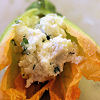
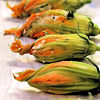
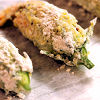

Crisp-Fried Squash Blossoms
adapted from Big Small Plates
2 ears fresh corn
1 tsp olive oil
1/2 cup grated Monterey Jack cheese
1/2 cup fresh ricotta
2 T minced cilantro leaves
—
1/4 cup cornstarch
1/4 cup cornmeal
1/4 cup all-purpose flour
1/2 tsp salt
1/4 tsp freshly ground black pepper
1/4 tsp cayenne pepper
—-
1/2 cup buttermilk
vegetable or canola oil, for frying
—
12 to 18 very fresh squash blossoms
1/4 cup toasted pumpkin seeds
1/4 cup sour cream, mixed with the juice and zest of 1/2 lime
1 cup tomatillo red-chile salsa (homemade or a good store-bought brand), warmed
Cut the kernels off the cobs. Heat the olive oil in a skillet over medium-high heat and saute the corn 2 to 3 minutes. Set aside and allow to cool, then combine with the Jack cheese, ricotta, cilantro.
Open each blossom as gently as possible, and remove the stamen. Stuff each blossom with a spoonful of the cheese-corn mixture; the amount will vary with the size of your blossoms, but don’t be afraid to stuff them well. The flowers seem delicate, but they’re surprisingly resilient. If you need more room to work, peel the flower apart at one of the ‘seams’ between the petals; you’ll be able to pinch everything back together (within reason) using the filling as glue. Leave enough room to twist each blossom shut.
Set the stuffed blossoms on a wax-paper-lined cookie sheet and place in the fridge to set. Meanwhile, combine the cornmeal, cornstarch, flour, and seasonings in a shallow bowl; put the buttermilk in another shallow bowl. Dredge each stuffed blossom, first in the buttermilk, then in the flour mixture, shaking off the excess at each step. Return them to the wax paper, then refrigerate again briefly.
Set up a cooling rack topped with two layers of paper towels next to the frying area. Add oil to a shallow skillet to a depth at least half as high as the average stuffed blossom. (I used 2 cups in a 10-inch pan.) Heat oil to 375 degrees. Slowly lower the blossoms into the pan, four or so at a time to prevent crowding, turning each over as soon as the bottom side is golden brown. It will go rather fast, but if the coating turns dark brown immediately, back off on the heat a bit; you need enough time to melt the cheese. With a spider or slotted spoon, remove the crispy blossoms to the paper towels. Repeat until all blossoms are fried.
Spoon a bit of the warmed salsa on each plate, then top with 2 or 3 blossoms. Drizzle with the lime crema, and scatter toasted pumpkin seeds for garnish.
cookbooks, cooking, farmers markets, Mexican, other blogs, recipes
6 Comments »




Posted by Anita on 04.26.07 12:15 PM
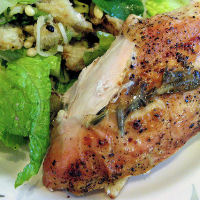 Here I was, feeling all smug about having cooked and eaten six days worth of local, affordable, and (dare I brag?) delicious food for the Penny-Wise Eat Local Challenge. And then I read CookieCrumb’s post about eating wheatberries to keep your carbs up… and instantly felt terribly guilty about all the bread we’ve eaten this week. But damn, this challenge was hard enough, even with all of the exemptions we claimed.
Here I was, feeling all smug about having cooked and eaten six days worth of local, affordable, and (dare I brag?) delicious food for the Penny-Wise Eat Local Challenge. And then I read CookieCrumb’s post about eating wheatberries to keep your carbs up… and instantly felt terribly guilty about all the bread we’ve eaten this week. But damn, this challenge was hard enough, even with all of the exemptions we claimed.
Every time I reached for a bottle of soy sauce or a pinch of chile, I repeated to myself a favorite quote from the Chronicle article profiling Cookie and her husband Cranky’s early take on the challenge: “One of the things you learn when you do this is that [eating] local is not a cult,” says [Cranky]. “You learn about things and you make exceptions.”
Keeping what I now call “The Cranky Principle” in mind, I’m proud of our results. We certainly did well in the budget department: Our 6-day food expenditures came to $123.73 — equivalent to $144.35 for a 7-day week, or just 35 cents over budget. (If you’re curious about all the gory details, feel free to peek at the spreadsheet, which also details the distance the food travelled to our plates. Oh, and there are some pictures — obviously not everything we ate is here, but it’s a good assortment.)
A few observations on our week:
We ate about the same quantity of food as usual, and about the same protein-to-carbs ratio. We ate more ground meat than we do in a typical week, although in truth I think that if I had had more time to plan my menu, and more time to shop around, could have done better in this regard.
 I bought more food at the grocery store than I usually do, and less from the farmers market. Sad to say, the ‘Big Organic’ producers like Earthbound Farms make it hard to walk by that $3 bag of (four!) romaine hearts when the budget’s tight. When it came down to it, I suspected the premium for farm-fresh produce would eat into the budget. I’ll be glad to leave the shrinkwrapped lettuce behind next week, though, and go back to my delicate Little Gems.
I bought more food at the grocery store than I usually do, and less from the farmers market. Sad to say, the ‘Big Organic’ producers like Earthbound Farms make it hard to walk by that $3 bag of (four!) romaine hearts when the budget’s tight. When it came down to it, I suspected the premium for farm-fresh produce would eat into the budget. I’ll be glad to leave the shrinkwrapped lettuce behind next week, though, and go back to my delicate Little Gems.
We didn’t do as good a job of eating seasonally as we could have. I’ll chalk some of this up to my not planning ahead sufficiently — we jumped into the challenge with less than 24 hours’ notice — but a lot of it did come down to the fact that the things we like to eat at this time of year aren’t terribly cheap, yet. So I fell back on a lot of the foods I used to make when money was tighter: Roast chicken, meatloaf, sandwiches, stir-fries… and lots of leftovers for lunch.
Speaking of lunch: Forgetting your brown bag can be disastrous. I left my chicken-salad sandwich in the fridge at home on Tuesday! Luckily, a short streetcar ride put me at the Ferry Building, where the Tuesday lunchtime market meant I had my choice of Donna’s tamales (too long a line), Prather or Taylor’s burgers (too pricey), Acme ‘sandwiches’ (too skimpy!), and Mijita’s chilaquiles. Guess which one this Mexican-breakfast addict chose? At $7 a plate, they’re not a bargain, but compared to Mijita’s other choices, they’re a steal. My forgetfulness did bust the budget, but only by the teensiest bit.
 Our revised alcohol budget of $9.75 per week for two people still seems incredibly low. We went to 150% of budget and spent $14, which bought us a six-pack of Speakeasy Untouchable Pale Ale and a 375 ml half-bottle of Bonny Doon Big House Red. And yes, we found ourselves standing in front of the fridge pondering the empty booze shelf by the middle of the week. Next time, maybe we’ll buy a big bottle of Anchor’s Old Potrero Rye and drink a fifth of it — very slowly — mixed with good ol’ Hetch-Hetchy branch water. (Doesn’t sound very food-friendly, does it?)
Our revised alcohol budget of $9.75 per week for two people still seems incredibly low. We went to 150% of budget and spent $14, which bought us a six-pack of Speakeasy Untouchable Pale Ale and a 375 ml half-bottle of Bonny Doon Big House Red. And yes, we found ourselves standing in front of the fridge pondering the empty booze shelf by the middle of the week. Next time, maybe we’ll buy a big bottle of Anchor’s Old Potrero Rye and drink a fifth of it — very slowly — mixed with good ol’ Hetch-Hetchy branch water. (Doesn’t sound very food-friendly, does it?)
I definitely enjoyed taking part in the challenge. Even though most of our food already came from local or semi-local sources, participating here opened my eyes to both the variety of items in our foodshed, and the distances that even our ‘local’ farmers market food travels to get to our kitchen. I have to admit that I’m looking forward to being able to just shop and cook from the hip, without taking notes or making calculations. And I know that despite all of the ways we stretched the rules, we learned a lot.
Most of the participants are just past the halfway mark of their challenge — we started early and shortened our week to 6 days due to a previous dinner commitment tonight and a weekend full of travel. For an amazing peek into the nuts and bolts of eating locally, check out all 20 of the participating bloggers over on the PELC roundup page. I’m utterly in awe of folks who are giving this a go in places like Maine and Syracuse, where spring has just barely sprung.
cooking, farmers markets, locavore, other blogs, shopping
Comments Off on Our Penny-Wise week




 Oh, hi — are you still here? Dang, sorry about that. We’ve done the metaphorical equivalent of falling asleep at the WordPress dashboard, and yet you kept coming by. That’s so sweet.
Oh, hi — are you still here? Dang, sorry about that. We’ve done the metaphorical equivalent of falling asleep at the WordPress dashboard, and yet you kept coming by. That’s so sweet.

















 “Best of the Ferry Building” Gift Basket
“Best of the Ferry Building” Gift Basket



















 It’s been a gazpacho-filled summer for us. In addition to the traditional Spanish soup’s regular appearances on our warm-weather menus, we kicked off tomato season with Cookie’s gloriously
It’s been a gazpacho-filled summer for us. In addition to the traditional Spanish soup’s regular appearances on our warm-weather menus, we kicked off tomato season with Cookie’s gloriously 




 Every summer, I walk by baskets of squash blossoms at the farmers market, longing to find a use for them. Stuffing fragile flowers seemed like a tedious task for a weeknight meal, so I’d always given them a pass. But once I saw
Every summer, I walk by baskets of squash blossoms at the farmers market, longing to find a use for them. Stuffing fragile flowers seemed like a tedious task for a weeknight meal, so I’d always given them a pass. But once I saw 




 Here I was, feeling all smug about having cooked and eaten six days worth of local, affordable, and (dare I brag?) delicious food for the
Here I was, feeling all smug about having cooked and eaten six days worth of local, affordable, and (dare I brag?) delicious food for the  I bought more food at the grocery store than I usually do, and less from the farmers market. Sad to say, the ‘Big Organic’ producers like Earthbound Farms make it hard to walk by that $3 bag of (four!) romaine hearts when the budget’s tight. When it came down to it, I suspected the premium for farm-fresh produce would eat into the budget. I’ll be glad to leave the shrinkwrapped lettuce behind next week, though, and go back to my delicate Little Gems.
I bought more food at the grocery store than I usually do, and less from the farmers market. Sad to say, the ‘Big Organic’ producers like Earthbound Farms make it hard to walk by that $3 bag of (four!) romaine hearts when the budget’s tight. When it came down to it, I suspected the premium for farm-fresh produce would eat into the budget. I’ll be glad to leave the shrinkwrapped lettuce behind next week, though, and go back to my delicate Little Gems. Our
Our